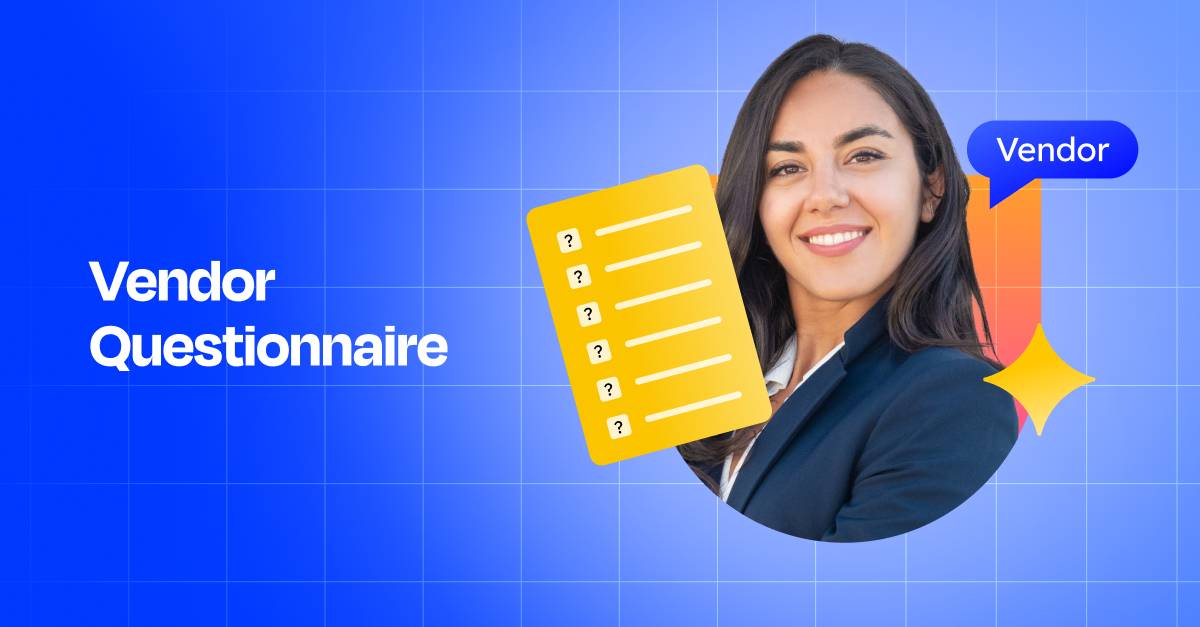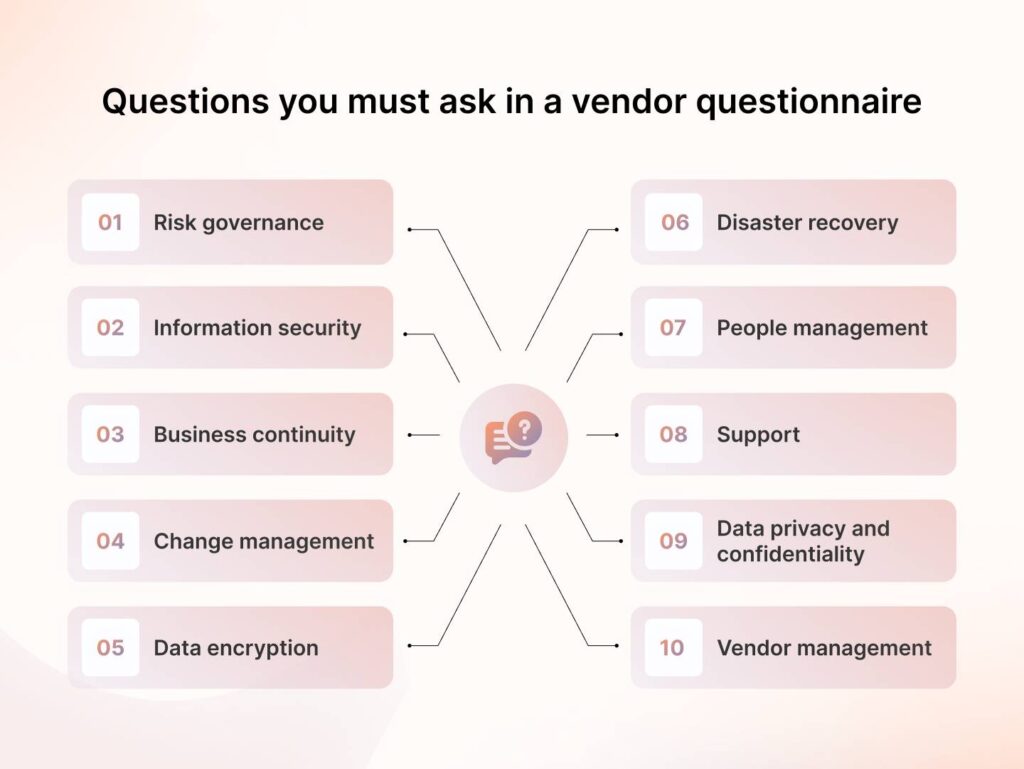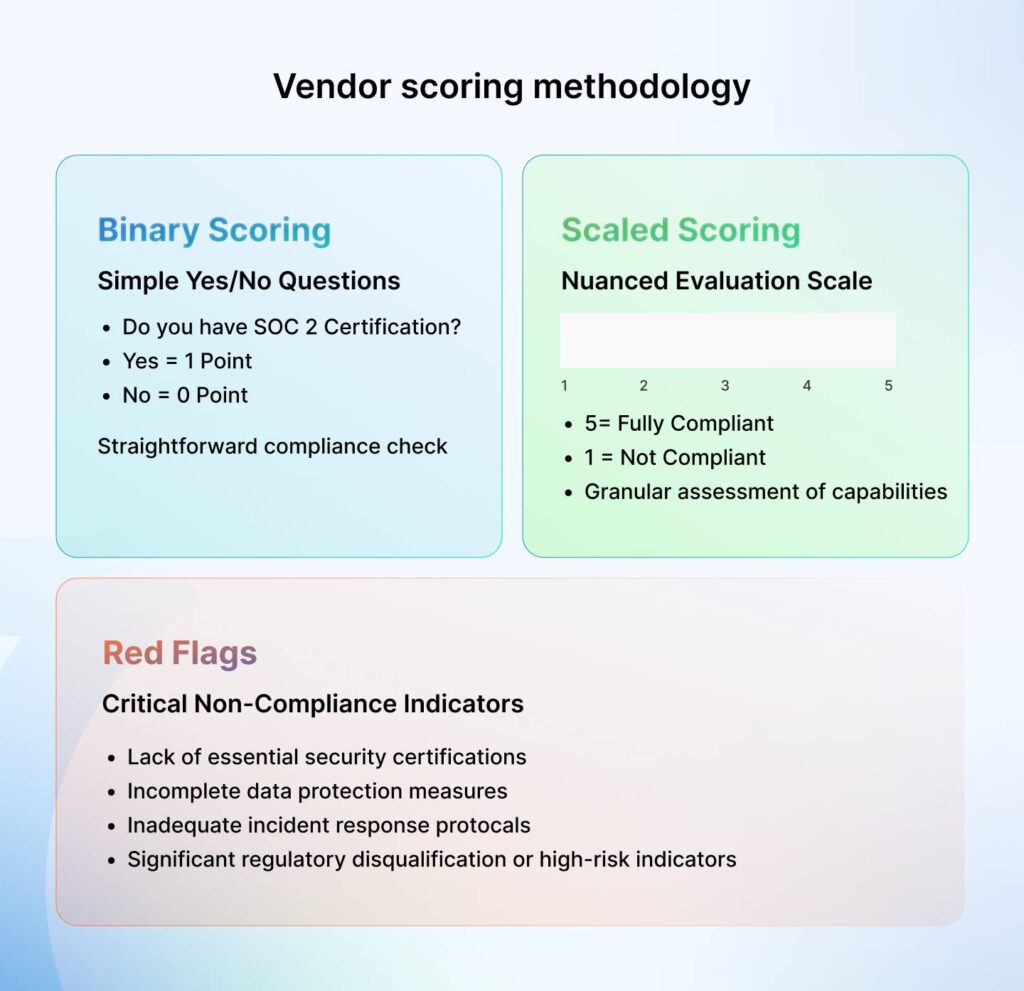Vendor Questionnaire: 95+ Questions Across Multiple Domains
Pansy
Dec 13, 2024
Vendors are more than just service providers—they’re an integral part of your business operations. But here’s the catch: 61% of data breaches now stem from third-party vendors. That’s a stark reminder of the risks tied to vendor relationships.
Vendor due diligence questionnaires form a crucial part of your vendor onboarding process. You need to make sure that their processes and policies align with your current security posture and it won’t disrupt anything once integrated.
So, how can you ensure that a vendor won’t pose a security risk to your business? Here are some key questions to include in your vendor questionnaire to help assess their security practices.
Questions you MUST ask in a vendor questionnaire (with domains)
The questions that you must ask in your vendor security assessment questionnaire should fall under several domains:

To make things easier for you, we’ve structured the following 97 questions according to the above domains.
A. Risk governance
Questions around risk governance domain probes into the vendor’s systematic methodology for understanding and managing uncertainties that could impact their business operations, financial performance, and strategic objectives. You should ask questions like:
- Do you have a formal risk governance plan for your Risk Management program?
- Do you perform annual risk assessments?
- Does your risk plan address threats like cyber risks, natural disasters, and business changes?
- Is there a governing body overseeing the risk governance plan?
- Do subcontractors access sensitive systems or data? How is this managed?
- Do you have a third-party risk management program?
B. Information security
The information security domain evaluates the depth and effectiveness of a vendor’s cybersecurity infrastructure, examining their defensive mechanisms, monitoring capabilities, and incident response protocols. The questions related to this domain include:
- Are your information security policies approved and communicated?
- Do you ensure the confidentiality, integrity, and availability of sensitive data?
- Are access controls and user authentication measures in place?
- Is data securely transmitted, including encryption protocols?
- Do you securely handle and dispose of sensitive information?
- Are systems protected from malware and cyber threats?
- Do you monitor and respond to security events?
- Do you address insider threats like data theft or sabotage?
- Are third-party vendors compliant with your security policies?
- Are your information security policies reviewed annually?
C. Business continuity
Business continuity explores a vendor’s preparedness and resilience in maintaining critical operations during unexpected disruptions, whether caused by technological failures, natural disasters, pandemics, or other significant events. You can assess this with questions like:
- Are critical business processes prioritized in your continuity plan?
- Do you ensure system availability through backups and recovery?
- Is there a crisis communication procedure in place?
- Is your continuity plan regularly tested and updated?
- Do you have redundant systems for service continuity?
- Do you test IT infrastructure for disaster recovery?
D. Change management
How systematically does your vendor manage technological upgrades, process modifications, and organizational transformations? Such questions related to change management can be terms as:
- Is there an approved change management policy?
- Do you track and log application code changes?
- Do you monitor regulatory changes across all regions of operation?
- Is there a designated team or individual responsible for regulatory updates?
- Do you assess the impact of regulatory changes on your business?
- Are regulatory changes communicated to relevant teams promptly?
- Do you update policies and procedures to align with new regulations?
- Is training provided to employees on recent regulatory changes?
- Do you maintain documentation of actions taken in response to regulatory updates?
E. End-user device security
End-user device security addresses the vulnerabilities and potential risks associated with laptops, desktops, smartphones, tablets, and other end-point devices that connect to corporate networks and store sensitive information. To understand how your vendor protects against end-user security issues, ask:
- Are device security standards reviewed annually?
- Do devices auto-lock after inactivity?
- Are remote access and file-sharing encrypted and authenticated?
- Are device logs detailed enough for incident investigations?
- Is there a mobile device management program?
- Are workstations equipped with screen-locking mechanisms?
F. Data encryption
Data encryption is used to verify the vendor’s methods of protecting data at rest and in transit. Example questions in this domain include:
- Do you encrypt data in transit?
- Do you encrypt data at rest?
- Do you use key management systems (KMS) to secure encryption keys?
- Are encryption protocols reviewed and updated annually?
- Do you use end-to-end encryption for sensitive communications?
- Is encryption implemented for data on portable devices and media?
- Do third-party vendors comply with your encryption standards?
- Do you change your secret digital keys frequently to prevent potential security breaches?
- Is decryption access strictly limited and logged?
G. Compliance
Knowing your vendor complies with cybersecurity standards is a testament to trusting them. This domain is key to understanding their security posture. Ask the following questions along with proper due diligence:
- Are you certified for standards like HIPAA, ISO 27001, or SOC 2?
- Are your compliance policies aligned with industry standards and regulations?
- Do you conduct regular internal audits to ensure compliance?
- Are compliance requirements tracked for all operating regions?
- Is there a designated compliance officer or team?
- Do you maintain evidence of compliance for audits and inspections?
- Are compliance metrics regularly reported to stakeholders?
- Do you have a whistleblower policy for reporting compliance violations?
Questions to assess for ISO 27001 compliance
- Is there an established Information Security Management System (ISMS)?
- Are risk assessments conducted regularly to identify and mitigate risks?
- Are roles and responsibilities for information security clearly defined?
- Do you have documented policies for incident management and response?
- Are corrective actions tracked and reviewed during internal audits?
Questions to assess for SOC 2 compliance
- Which Trust Service Criteria (TSCs) are included in your SOC 2 report?
- Are access controls in place to restrict unauthorized access to data?
- How is data availability ensured during system disruptions or outages?
- Are encryption standards followed for data in transit and at rest?
- Is there an annual review process to maintain SOC 2 certification?
Questions to assess for GDPR compliance
- Is personal data processing documented and lawful under GDPR principles?
- Are Data Protection Impact Assessments (DPIAs) conducted where required?
- Is a Data Protection Officer (DPO) appointed, if mandated by GDPR?
- How do you ensure compliance with data subject rights (e.g., access, erasure)?
- Are data breaches reported to the relevant authority within 72 hours?
Questions to assess for HIPAA compliance
- Is there a designated Privacy Officer and Security Officer for HIPAA oversight?
- Are physical, technical, and administrative safeguards in place for PHI?
- How are Business Associate Agreements (BAAs) managed and enforced?
- Are regular training sessions conducted for employees on HIPAA compliance?
- Is there a documented process for handling potential PHI breaches?
Questions to assess for NIST compliance
- Which NIST framework is followed (e.g., CSF, 800-53)?
- Are security controls mapped to specific organizational risks?
- Is there a documented process for continuous monitoring of systems?
- How is the effectiveness of implemented security controls evaluated?
- Are incident response plans tested regularly for readiness?
H. Physical security
Physical security focuses on preventing unauthorized physical access and protecting physical infrastructure, personnel, and assets from potential security threats. Questions in this domain include:
- Do you prevent unauthorized physical access to facilities?
- Are emergency safety measures in place for employees and visitors?
- Are physical security controls tested and updated regularly?
- Do you monitor access to sensitive areas like servers?
I. Network security
Your vendor must aim to protect network infrastructure, data transmission, and prevent unauthorized network access and potential cyber threats. You an evaluate on the basis of questions like:
- Do you use an intrusion prevention system (IPS)?
- Do you use intrusion detection systems (IDS) and retain logs?
- Are network access and data monitoring policies documented?
- Do you conduct external penetration tests annually?
- Do you have a Network Security Policy?
- Are production hosts protected by deny-by-default firewalls?
- Is multi-factor authentication (MFA) used for remote access?
J. Disaster recovery
The disaster recovery domain assesses the vendor’s ability to recover and restore critical systems after a major incident. To understand how they do so, ask questions like:
- Have you experienced a disaster recovery event recently?
- Do you test your disaster recovery plan regularly?
- Is your disaster recovery plan reviewed annually?
- Do you have a documented Disaster Recovery Policy?
- Are failures in critical controls addressed promptly?
- Are production databases backed up for disaster recovery?
- Is there a documented Data Backup Policy?
K. People
To evaluate human resource practices related to security and confidentiality, you must ask questions related to training, background checks, onboarding, etc. Examples include:
- Do employees receive training to handle sensitive data?
- Are background checks conducted for staff with sensitive access?
- Are company policies reviewed during onboarding?
L. Support
You must be aware of how your vendor supports its customers and third parties with technical problems and if they are proactive about resolving issues. Ask questions like:
- Do you provide customers with a way to report incidents or complaints?
- Do you track and resolve customer support tickets promptly?
- Is there a process to escalate unresolved support issues?
- Do you provide customers with a Service Level Agreement (SLA)?
- Are customer support teams trained to handle sensitive information securely?
- Do you have multilingual support capabilities for global customers?
- Are customer satisfaction metrics monitored and reported?
- Do you have a process for handling support-related incidents or breaches?
M. Data Privacy and Confidentiality
If you comply with regulations related to data privacy and confidentiality like SOC 2, ISO, GDPR, etc, you must ask questions related to how your vendor lives up to it.
- Do you have a Confidentiality Policy for employees?
- Are measures in place to address risks when sharing personal data with vendors?
- Is there a Data Protection Policy for handling personal data?
- Do you conduct regular Data Protection Impact Assessments?
N. Vendor Management
Your vendor has vendors too and when you integrate with them, you must be aware of how their third-party risk management strategy looks like. To evaluate the same, ask the following questions:
- Do you have a Vendor Management Policy?
- Do you perform regular vendor risk assessments?
- Are subservice organizations periodically reviewed?
- Are vendor contracts reviewed for compliance with your security policies?
- Do you maintain an updated inventory of vendors and their access rights?
- Are vendors required to sign non-disclosure agreements (NDAs)?
- Is vendor performance evaluated against agreed service levels?
- Do you monitor vendors for cybersecurity or data privacy incidents?
- Are vendors required to comply with certifications like SOC 2, ISO 27001, etc.?
- Is there a process for terminating vendor relationships securely?
How do you analyze the answers and assess vendors based on the questionnaire?
1. Define your evaluation criteria
A good vendor evaluation process starts with a clear, structured framework. Identify critical domains you want to evaluate your vendor on like security, compliance, and operational capabilities.
The best way forward is to develop a weighted scoring matrix that prioritizes your assessment criteria based on your organization’s specific risk tolerance.
2. Create a scoring methodology

Common types of scoring methods that you can use in your vendor questionnaires include:
- Binary Scoring: Use “Yes/No” answers for straightforward questions (e.g., “Do you have SOC 2 certification?” Yes = 1 point, No = 0 points).
- Scaled Scoring: Rate nuanced answers on a scale (e.g., 1 to 5, where 5 = fully compliant and 1 = not compliant).
- Red Flags: Flag responses that indicate non-compliance with critical requirements.
Such methods make it easy for you to assess multiple vendors at once and automate the process to some extent.
3. Benchmark against compliance frameworks
Compare vendor responses against industry standards and regulatory requirements. Validate responses using established benchmarks like SOC 2 and ISO 27001. Your vendors should not only meet basic compliance requirements but also align with best practices in their respective industries.
| Example: A vendor responds to the question: “Do you encrypt sensitive customer data both in transit and at rest?” SOC 2 compliance benchmark: Under the Security criterion, a vendor should ensure that sensitive information is protected using encryption and other security controls. A positive response (e.g., “Yes, we use AES-256 encryption for data at rest and TLS 1.2 for data in transit”) would meet the standard’s expectations. ISO 27001 benchmark: According to ISO 27001, the vendor should have policies around the protection of confidentiality and risk management. The vendor’s response aligns with the standard’s emphasis on implementing strong technical controls. However, to align fully with the ISO standard, the vendor would need to provide more detailed policies about risk management, access control, and monitoring. |
4. Categorize according to risk level
A proactive approach to third-party risk management is classifying your vendors in the initial stages according to how big of a risk they pose to your business. Common risk classifications include:
Low Risk: Fully compliant vendors with robust security and processes.
Moderate Risk: Partially compliant vendors that need minor improvements.
High Risk: Vendors with significant gaps in security, compliance, or transparency.
5. Monitor continuously
Vendor assessment is not an event but a process. Schedule cycles of periodic reevaluation of vendors’ performance, compliance, and areas of potential risk. Your vendor ecosystem should be in line with the standards of your organization and changing business needs.
| “Managing vendors has become much easier with Sprinto. No one enjoys supplier management as it’s often one of the most tedious tasks in any company. Now, it only takes half an hour a month to go through it all. It’s something I can do on the go because it’s no longer overwhelming.” – Adéle Tredoux, Head of GRC at Resonance Labs, a part of Mesmerise |
The future of vendor due diligence with AI
AI can speed up, smarten, and scale up almost any process, and vendor due diligence isn’t shying away from that. The traditional form of due diligence was very manual and time-consuming, and mostly based on spreadsheets and long review cycles.
AI can interpret free-text responses and compare them against best practices and industry regulations almost instantly. It uses natural language processing to accelerate decision-making and make vendor assessments future-proof.
This is especially critical for mid-sized companies and enterprises that integrate with multiple vendors on a daily basis.
Here’s an example:
On the Sprinto app, when your vendor uploads due diligence documents like SOC 2 or ISO 27001 reports, Spinto AI can review these docs to answer the vendor security assessment questionnaires.
From there, you’ll find auto-generated key findings that verify all the source information for accuracy. This saves time and improves clarity in your vendor management process.
Here’s a video for better understanding:


Use Sprinto to centralize security compliance management – so nothing
gets in the way of your moving up and winning big.






















